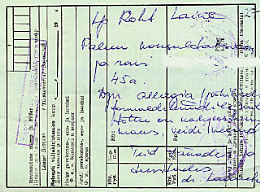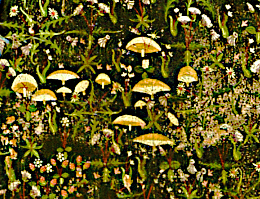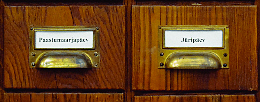Mäetagused vol. 62
Summary
-
Nonverbal event as part of belief narrative
Reet Hiiemäe
Keywords: belief narrative, narration, nonverbal behaviour, nonverbal communication
A communicative act that involves the presence of two or more persons always contains a nonverbal aspect. The focus of the article is on nonverbal situations as a basis for the evolution of belief narratives. This pre-narrative aspect has not received much attention in narrative research as most analyses are based on texts that already exist in verbalised form. However, on many occasions the basis for a belief narrative is a nonverbal act that has triggered its witness or re-narrator(s) to interpret it in the framework of a vernacular belief. Hence, texts that contain a nonverbal part consist of two components: 1) description of a nonverbal occurrence; 2) its meaning/interpretation that is verbalised by the narrator in the framework of a topical belief tradition. By bringing examples from Estonian belief narratives, the author points out some models and patterns that leap to the eye in texts narrating about nonverbal occurrences (e.g. the context of described situations, the types and results of activities described, etc.). As a theoretical basis, works on communication theory and vernacular belief research are used.
-
-
 To a folk healer with a doctor’s referral letter
To a folk healer with a doctor’s referral letter
Mare Kõiva
Keywords: alternative medicine, doctor’s note, folk healer, folk medicine, healing rite, Laine Roht
The article discusses one of the healing strategies used by Laine Roht, a well-known folk healer from southern Estonia, in the 1980s; namely, she demanded that the patients turning to her bring a referral letter from their doctor. This kind of behaviour was a response to the state’s prohibition of folk medicine methods, and aimed to promote the image that the healer worked in cooperation with professional physicians. These referral letters from medical doctors as well as other written documentation concerned with healing constitute interesting folkloric and psychological research material. The article gives an overview of the healing rituals applied to the patients, diagnoses with which they turned to the healer, the origin of both doctors and patients, and the role of printed materials in the 20th-century healer’s tradition and her healing ritual. The author also characterises contemporary media images of healers and the role of the media as basis for the healer’s fame.
-
-
Folk dance activities and participation in grand events: Reasons and correlations with subjective wellbeing
Stanislav Nemeržitski, Iivi Zajedova
Keywords: folk dance, leisure activities, subjective wellbeing
Big festivals and folk culture events have been a centuries-old tradition in Estonia. Today, alongside the preservation of national traditions and being cultural events, these events have also become popular leisure activities. Leisure activities are known for their positive effect on humans’ subjective wellbeing through emotional, social and psychological effects. This article focuses on adults’ motivation, both in Estonia and abroad, to engage in folk dance activities and their possible impact on subjective wellbeing. The study was carried out among Estonians living in Estonia and abroad, and it was designed as a mixed methods research. The results indicate that social factors play an important role in motivating adults to engage in folk dance, but also educational aspects are involved, which contribute to the general wellbeing of a folk dancer.
-
-
 Mushrooms in Christian art in the Autumn of the Middle Ages
Mushrooms in Christian art in the Autumn of the Middle Ages
Ülle Sillasoo
Keywords: ethnomycology, Late Gothic art, mushrooms
Medieval and Early Modern sources were researched for the depictions of mushroom species and their uses. Mushroom depictions in four paintings – the Wilton Diptych, the Madonna of Carinthian provenance, and two examples of the Crucifixion of Christ of Nuremberg provenance – were identified and discussed. The species shown in these works include Amanita muscaria, Clitocybe odora, Lactarius cf. lilacinus, Leccinium aurantiacum s.l., Lycoperdon perlatum, and Marasmius oreades. Mushrooms growing in fairy rings were found to be landscape metaphors alluding to the apparition of the Virgin Mary. Mushrooms shown growing near the white deer in the outer panel of the Wilton Diptych supposedly refer to both the mystical animal and the forest. Through the colour of the red-capped scaber stalk and the usage of the common puffball, the wounds, blood, and suffering of Christ are manifested. Like other vegetal symbols in the art of the period, mushrooms in these paintings reflect the knowledge, beliefs, and realities of ‘home’ environments of those depicted in the paintings.
About us
-
 Seven wishes: Expectations and realizations 1967–2015
Seven wishes: Expectations and realizations 1967–2015
The presentation by Ave Goršič at the festive ethnomusicology seminar at the Estonian Literary Museum on November 6, 2015, dedicated to Ingrid Rüütel’s 80th jubilee, is a retrospect of the jubilarian’s expectations once written down by her in view of the developments of the Estonian Folklore Archives, with an overview of their realisation by today.
-
-
Richard Viidalepp as a folklore collector and a colleague
Transliteration of Pille Kippar’s oral presentation at the conference of the Academic Folklore Society, “Fieldwork on a Time Scale”, on October 30, 2015.
News, overviews
-
In memoriam
Viire Villandi (August 15, 1955 – September 3, 2015)
The eulogy is written by Mare Kõiva.
Aleksander Heintalu (May 31, 1941 – August 19, 2015)
The eulogy is written by Mare Kõiva.
-
-
Birthday Greetings!
Veljo Tormis (85), Pille Kippar (80), Ingrid Rüütel (80), Vilmos Voigt (75), Enn Ernits (70), Tarmo Kulmar (65), Anu Korb (65), Irina Sedakova (60), Terry Gunnell (60), Piret Õunapuu (60), Guldžahon Jussufi (60), Tiiu Jaago (55), Marju Kõivupuu (55), Anneli Baran (45), Katre Õim (45), Helen Kõmmus (40)
-
-
Cooperation between heritage archives of the Nordic and Baltic countries
Ave Goršič writes about a seminar organised by the Network of Nordic and Baltic Tradition Archives in Oslo, a working meeting at the Danish Folklore Archives on August 18, and a meeting in Zagreb dedicated to the legislation concerned with archives.
-
-
International conference “Cultures of Sense: Approaches to the Sensuality of the Social World” in Zurich
An overview of the conference is given by Reet Hiiemäe.
-
-
Conference of folk cultures at Tallinn University
Iivi Zajedova writes about the conference “Big Festivals of Estonian Culture as Part of World Heritage”, which took place at Tallinn University on September 14.
-
-
Collecting and fieldwork, present and past
Katre Kikas gives an overview of the conference of the Academic Folklore Society, “Fieldwork on a Time Scale”, on October 30.
-
-
Belorussian culture researchers are eager to enter European research space with the help of the Estonian Literary Museum
Renata Sõukand gives an overview of the cooperation between Estonian and Belorussian researchers.
-
-
Calendar
A brief summary of the events of Estonian folklorists from July 2015 to December 2015.
-

-
About musical heritage in Saaremaa: A collection of scholarly and practical value.
Ingrid Rüütel. Saaremaa laule ja lugusid. Mis on jäänud jälgedesse I. ELM Scholarly Press. Tartu, 2015. 400 pp.
Ingrid Rüütel. Saaremaa laule, tantse ja kombeid. CDs and DVDs from the series Helisalvestusi Eesti Rahvaluule Arhiivist 8. ELM Scholarly Press. Tartu, 2014.
An overview by Helen Kõmmus.